- AI lead generation automates the full funnel: finding, qualifying, and contacting leads.
- It works by using behavior signals, chat flows, and CRM data to score and route prospects.
- Strong AI lead gen systems start with a clear traffic source, lead magnet, and qualification criteria.
- Ongoing improvement is key to AI lead gen — feedback loops and testing drive long-term performance.
Matea Vasileski and Milos Arsik have helped hundreds of companies automate business processes — data entry, onboarding, research, tracking.
And the most popular service they offer? The only one that the majority of clients take them up on?
AI lead generation.
“It's so easy to set up that even if you don’t want to prioritize AI lead generation, it’s something every company should do,” explain Vasileski and Arsik, co-directors at AI firm Envyro.
They point to AI lead gen as the lowest-hanging automation for any company.
If you’re interested in introducing any type of enterprise agent or AI process to your company, AI lead gen is an easy way to start. I’m going to walk you through some tangible steps to get started — complete with insights from two guys who do it for a living.
Okay, ready? You could have an AI lead gen system set up in a week (really, really). Let’s get cracking.
What is AI lead generation?
AI lead generation is the process of using artificial intelligence to identify, attract, and engage potential customers without manual effort.
Companies that use AI report up to a 50% increase in lead gen and 47% higher conversion rates. Pretty cool, eh?
The success of AI lead gen comes in 3 stages: finding leads, qualifying leads, and engaging leads. Automation can strengthen each step of the process, saving human labor for only the highest value parts of the funnel.
AI lead gen systems always involve CRMs, and they often include AI tools like business chatbots or multi-pronged AI agents.
How can you use AI for lead generation?
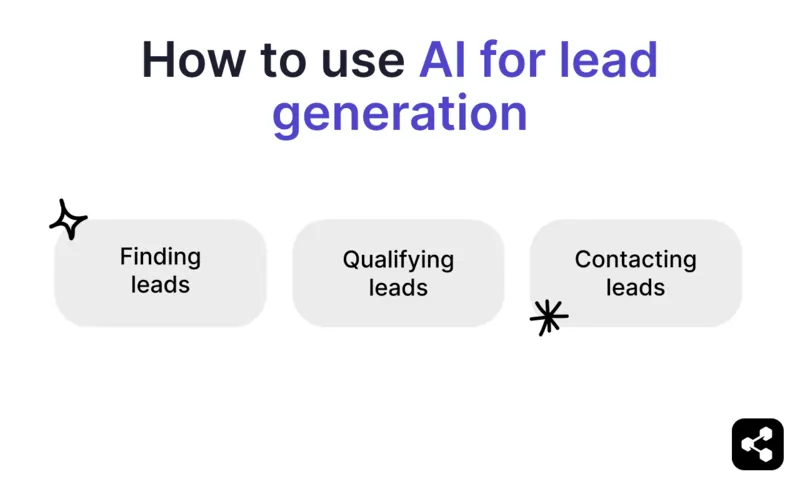
Two types of companies employ AI lead generation: companies with too many leads and companies with too few leads.
If you have too few leads, you’re gonna want your AI lead generation system to focus on finding leads and then contacting leads.
If you have too many leads, you’ll want AI lead generation to focus on qualifying leads and contacting leads.
1. Finding leads
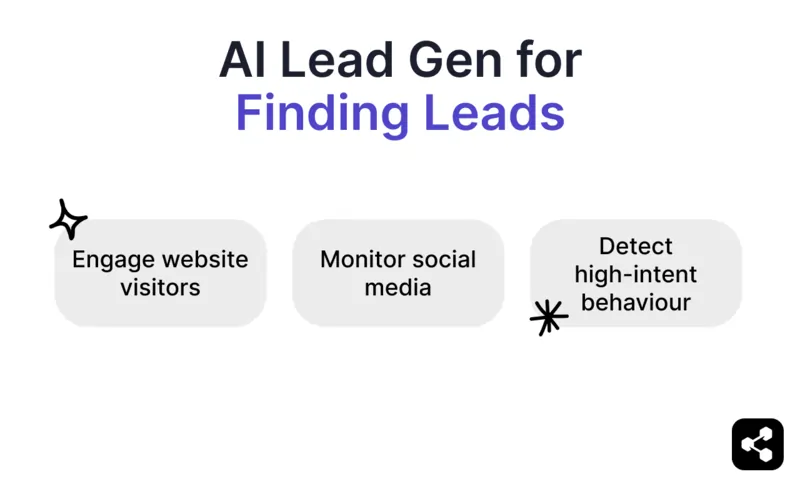
Let’s be frank: If your company is short on leads, an AI lead generation system isn’t going to magically fix it.
There are 3 main ways an AI chatbot can find new leads: engaging with website visitors, monitoring and/or engaging with social media or messaging apps, and detecting high-intent behavior.
But notice something important: All these activities come from existing activity.
Just like Cinderella’s fairy godmother couldn’t make something out of nothing (hence the pumpkin carriage), an automated lead gen tool can’t magically conjure up new interest in your company.
Engage website visitors
No matter what a website’s chatbot says it’s for, they all usually have the same purpose: lead generation.
Think about it — that could be you, using AI for sales, the way our tech overlords intended. But don’t be scared by the terrible rule-based chatbots of years past.
These days, an AI chatbot is less frustrating, Sisyphisian turmoil, and more fluid, on-demand help.
This is where your incentive shines. Does your chatbot offer a free consultation? A quick needs assessment?
If it’s a good enough carrot, then your website visitors start handing over their emails. Willingly. Happily, even. Ecstatically, perhaps, if your lead magnet is that good.
In short: Direct interaction turns passive visitors into leads.
Monitor social media
If you’re hooked up to social media, you should probably be using it as a potential lead source.
An AI tool can find leads on social media and messaging apps by monitoring interactions — and remember, it doesn’t need to be a single-use tool that just crawls social media. Keep your tech stack light; consider an all-in-one AI agent (I’m biased. But it’s also true.)
These kinds of tools can track who comments on posts, asks questions, clicks on ads, or visits repeatedly. Any or all of these actions can be billed as qualifying actions for leads.
Lead generation from social media will involve integrating an AI tool with your company’s social media platforms.
If this poses a barrier to development, there’s a simple fix: choose a chatbot platform that offers a pre-built integration with Facebook, Instagram, or whatever it is you use.
Detect high-intent behavior
Not all leads announce themselves by filling out a form or starting a chatbot conversation.
Some just lurk — but their behavior tells you they’re interested.
AI can track these subtle signals and turn warm interest into direct engagement. Here’s what to look for:
- Repeated visits to pricing or product pages – They’re weighing their options. AI can nudge them toward a conversation.
- Downloading a resource or signing up for a webinar – They’re interested in what you offer but might need a push.
- Engagement on LinkedIn or other platforms – A new follower or someone liking multiple posts? That’s a potential lead.
To set this up, enable website event tracking, define what actions count as high intent, and use AI-powered triggers to reach out before they lose interest.
2. Qualifying leads
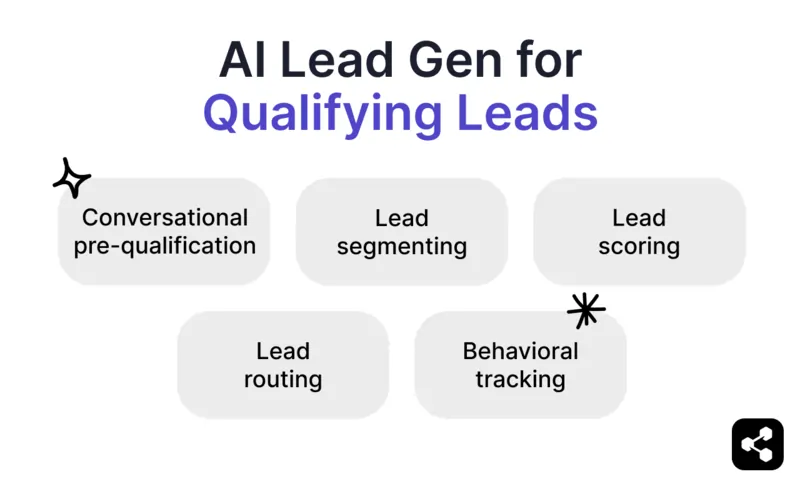
Quadrupling your leads is meaningless if they’re low-quality leads. Making your sales team crawl through hundreds of crappy leads is a great waste of money.
If you have enough leads, then the qualifying step is the most crucial one.
And if you’re nervous about offloading your lead qualification to robots, let me offer you an anecdotal antidote: a ton of our clients say that AI lead qualification is even better than a human.
Why? Humans get caught up in the wrong details (look up ‘bikeshedding’). And they’re not as good at pattern recognition. But AI is precise — and it can get better and better with time.
Conversational pre-qualification
Chatbots are really good at qualifying leads. You can design a conversational flow that sounds natural and dynamically adapts based on their answers.
And let’s be real: everyone hates forms.
(We actually have some real-world data on this below, in our case study for Waiver Group.)
You can design different flows based on anything: budget, use case, company size, industry, decision-making role, engagement level, specific pain points they mention, etc.
And don’t forget to give your user something in return: an insights report for their industry, the results to their personality assessment, or a video showing them how to 10x their leads.
Behavioral tracking
You don’t need someone to engage with your chatbot to qualify them. You can go a level deeper and qualify based on their actions.
Which actions? Usually things like pricing page visits, product page visits, time spent, downloads, demo requests — it all depends on your prospects and your business.
So if someone visits your pricing page 3 times but hasn’t reached out, you can instruct your AI agent to send a friendly outreach email.
Leading scoring, segmenting, and routing
A study from Harvard Business Review found that businesses using AI for lead scoring experience a 51% increase in lead conversion.
So, if you’re doing AI lead gen, you might as well implement a scoring system. How you want to score leads, that’s all you.
Based on whether a lead is hot, warm, or cold, you can instruct your AI agent to use different follow-up strategies.
Maybe a hot lead means a text message to your Head of Sales telling him to make a phone call, while a cold one gets an automated (but personalized) email.
If you’re segmenting your leads, your AI agent can route the right lead to the right person. Enterprise deals are routed to your CRO, while your LATAM deals are routed to your Spanish-speaking sales team.
3. Contacting leads
.webp)
If you want, a lead generation chatbot can go beyond delivering qualified leads – it can send follow-up emails or book discovery calls.
Best for: Non-urgent follow-ups, detailed information, nurturing sequences.
What to include: A personalized message and a clear next step (e.g., booking a call, downloading a resource).
Hot tip: Set up a sequence — first email right after the chatbot interaction, then follow-ups based on engagement.
Text (SMS or WhatsApp)
Best for: Immediate engagement, appointment reminders, short follow-ups.
What to include: Keep it concise — confirm interest, offer a CTA (e.g., “Reply YES to book a call”), and avoid spammy language.
Hot tip: Ensure leads have opted in to receive messages to avoid legal issues.
Phone call
Best for: High-value leads, urgent follow-ups, complex sales conversations.
What to include: AI can score leads to prioritize those who need a call, provide call scripts based on chatbot interactions, and even suggest talking points.
Hot tip: Call soon after engagement — hot leads go cold fast.
Social media
Best for: Engaging leads where they’re active, answering follow-up questions, nurturing relationships.
What to include: Personalized responses based on chatbot history, links to relevant content, casual but professional messaging.
Hot tip: Send messages when leads are most active on the platform for higher response rates.
Examples of AI Lead Generation Case Studies
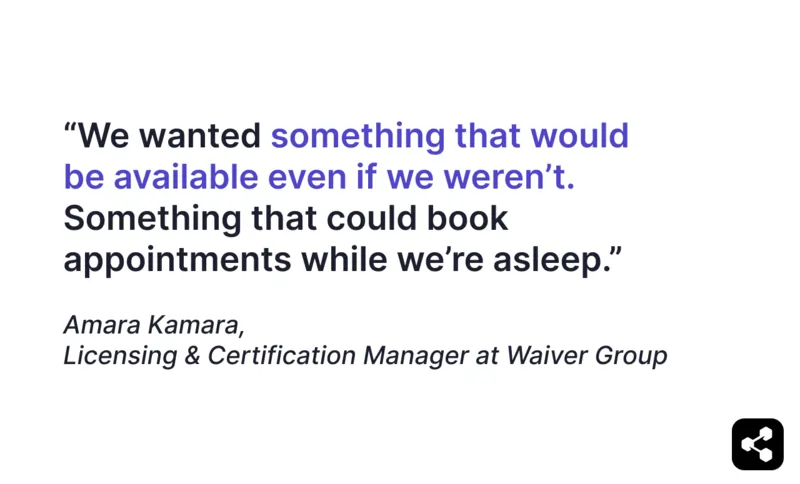
Waiver Group’s 25% increase in leads
This chatbot was built by one of our talented partner organizations — and it delivered a positive ROI in just 3 weeks.
The Waiver Group (a healthcare consulting firm) had 2 goals: book more consultations, and qualify leads without additional manual work.
Waiverlyn – a lead-generation-and-scheduling bot – solved both. And very quickly. The bot had 3 main functions:
- Booking consultations
- Qualifying leads
- Onboarding clients
Book consultations automatically
The bot creates Google Calendar events, supplements descriptions with prospect information, adds video conferencing links, and sends detailed email invites to both guests and employees.
Streamline lead qualification and management
Waiverlyn gathers detailed contact and qualification data, automatically updates the sales team’s Google Sheets, and notifies key team members by email.
This allows the sales team to seamlessly integrate the chatbot’s capabilities into their existing platforms and workflows – all the benefits of efficiency without the disruption.
Accelerate client onboarding
As Amara Kamara, Licensing & Certification Manager at Waiver Group, explained: “Some of our clients know exactly what they want and want to get started right away. Waiverlyn can send them right to our self-serve portal where they can create an account and start uploading their documents.”
Spacelist’s higher engagement-to-lead rate
Leading commercial real estate website, Spacelist, with almost 100k visitors each month, was trying to improve engagement — as some users browse listings and leave without inquiring about a listing.
Existing lead capture methods offered static engagement, causing potential high-intent visitors to slip through the cracks.
What were the key challenges?
- Limited Interaction: No immediate, conversational way to address user questions.
- Passive Conversion: Static forms yielded direct-inquiry based leads, but lacked real-time engagement.
- Underutilized Traffic: With so many visitors, even a small improvement in engagement could translate to sizable gains.
Envyro introduced an AI-driven real estate chatbot to proactively engage users, answer property-related queries, and seamlessly collect contact information.
The chatbot acts as a virtual leasing and sales assistant, guiding potential buyers and renters through to relevant listings and/or qualified real estate professionals.
Hundreds of new qualified leads
Within the first month, the chatbot accounted for a noticeable percentage of new leads with completed profiles coming through the website.
Higher engagement-to-lead rate
Visitors who interacted with the chatbot were significantly more likely to share their details compared to passive form users.
Enhanced agent efficiency
By creating dynamic responses to user inquiries and qualifying leads by enriching their profiles, the chatbot streamlines the real estate agents follow-ups and improves efficiency and effectiveness.
The Best AI Lead Generation Software
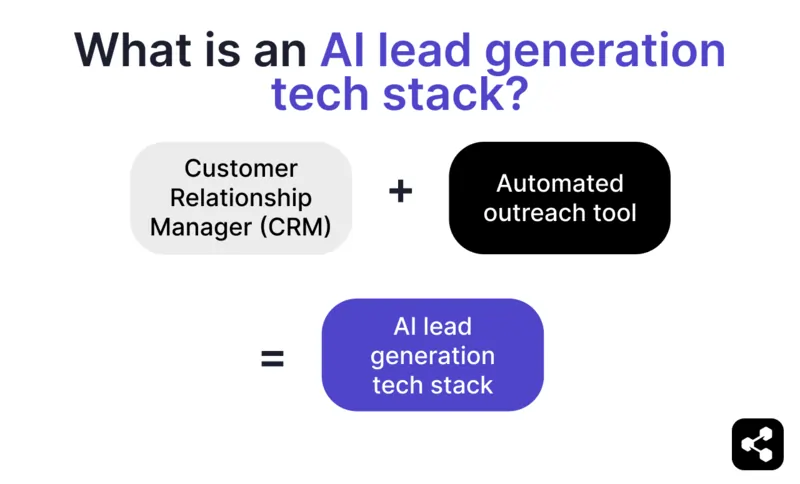
Despite what so-called ‘LinkedIn-fluencers’ want you to believe, AI lead generation doesn’t require an intense tech stack. You’ll need 2 tools: A CRM and an automated outreach tool. That’s it.
If you’re using a CRM that can send emails, then all you need is an AI system to coordinate the knowledge, make decisions about leads, and initiate communications.
CRM
The core of your AI lead gen system will be your CRM. Without a CRM (like HubSpot or Salesforce or Zendesk), it’s obviously gonna be tough to track leads.
Connecting your AI tool to your CRM is integral to your whole AI lead gen system.
You know what else is integral? Properly tracking engagement with leads in that CRM.
So if you have a sales team beyond yourself, you’ll need to whip them into shape with keeping it up-to-date.
AI uses data; the data needs to be current. Look up ‘garbage in, garbage out’ if you’re unfamiliar with the phrase.
Automated outreach tool
Your automated outreach might look like an AI-powered email platform (lame), a chatbot (cool), or a multi-purpose AI agent (super cool).
Why is an AI-powered email platform lame?
Your CRM should already have email functionality, and the AI features on most CRMs aren’t advanced enough for real AI lead generation. That’s it.
So let’s talk about the AI chatbot and AI agent options.
The line between AI chatbots and AI agents blurs if you talk to sales & marketing teams. Everyone wants to sell an AI agent. Honestly? Either works for AI lead gen.
Chatbots and AI agents are capable of covering most anything you need in your AI lead generation flows (with the huge caveat that you’ll need to use a flexible platform. Those plug-and-play solutions will not hold up once you want to start customizing.)
You can use ‘em for data collection, lead capture, lead qualification, lead scoring, automated outreach, and analytics.
You can check out my list of the best AI chatbot platforms if you’re looking to get started.
(I’ll give a biased tip: Botpress has built-in integrations with all the major CRMs: HubSpot, Salesforce, Zendesk. Even a few you've never heard of, just to be safe.)
How to Set Up AI Lead Generation: Step-by-Step
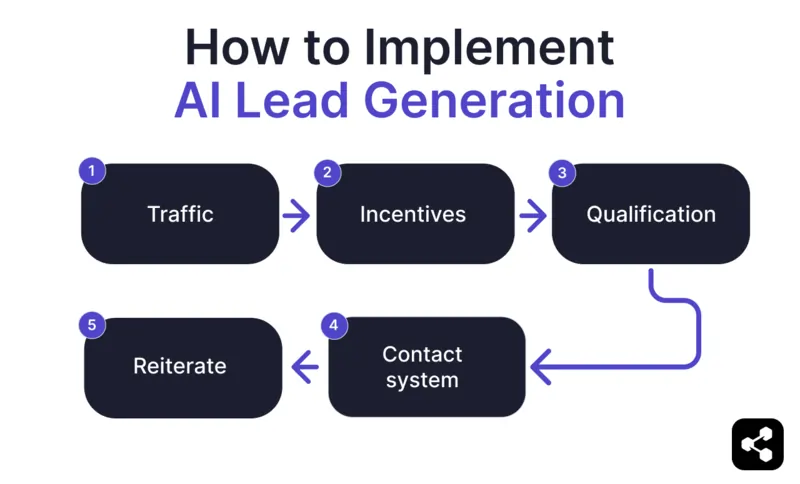
1. Figure out where traffic will come from
As we discussed above, AI lead gen doesn’t conjure leads from thin air. So figure out where your traffic is going to come from — paid ads? Content marketing?
This start to your AI sales funnel will determine how the rest is set up. If your company is already up and running, this is an easy step. If you’re just starting out, it’s time for a heads-down strategy session to figure it out.
2. Provide an incentive
“Having a reason is the most important thing,” says Vasileski. And it’s true – why would someone click on a company’s chatbot for fun?
If you’re trying to convert cold traffic from a landing page, you’ll need to give incentive for a visitor to engage.
Your incentive will vary depending on the type of lead you’re working with, your industry, etc. If a lead has already watched a 15-minute video case study testimonial, they’re warm enough that you don’t need to dangle a huge carrot for them to volunteer their contact information.
If a website visitor is totally unaware of your company when they land, you’ll need a lead magnet to draw them in. These could look like:
- A free assessment via chatbot that sends its results via email
- A customized PDF worksheet
- An offer for a market research report
3. Set up qualification parameters
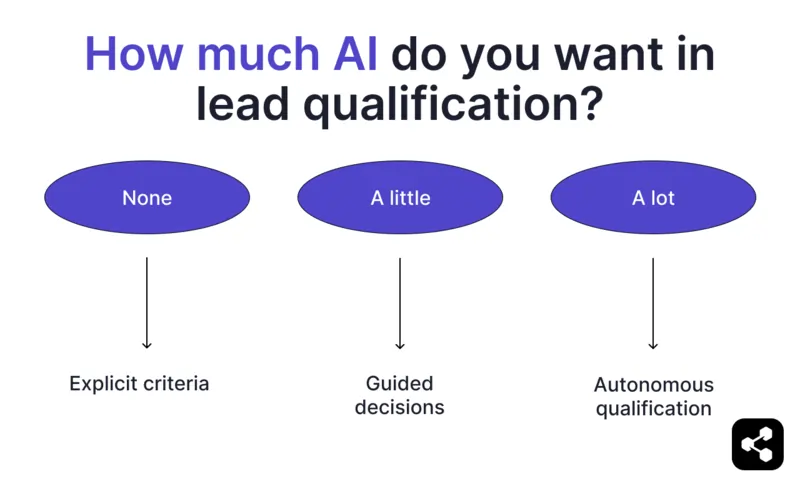
Once your source of leads is clear and you have an oh-so-enticing lead magnet, you can figure out what kind of leads are worth your time and how you’re gonna reach out to them.
If you don’t have an ICP, that’s a whole other issue. Figure it out before you start introducing AI.
If you’re solid on qualification parameters, you can decide how much of the decision you want to offload to AI.
But remember: You can always experiment with all 3, and see which does best for your business.
Explicit criteria
You can be straightforward with it. Instruct your bot to qualify anyone who states their budget as $10,000 and above. Easy. Simple.
This option is best for companies with a very clear ICP or other strict qualification rules.
This doesn’t require AI, but the other parts of your AI lead gen system will (i.e. generating personalized messages, etc).
But be warned: Rigidity might not be the best option for your team, even if it’s the easiest to implement. Let’s look at the AI options.
Guided decisions
Instead of a rigid yes/no system, you can instruct your AI agent to weigh multiple factors and then make an informed decision. This allows for some flexibility while keeping it anchored to clear rules.
It might want to consider:
- Engagement signals (Have they visited the pricing page multiple times?)
- Company size & industry (Are they in a sector that typically converts well?)
- Intent indicators (Did they ask about implementation timelines or integrations?)
Your AI agent can then use a scoring system to rank leads based on these signals. And a bonus: it can learn over time.
This method works well for companies that:
- Want more flexibility in how leads are qualified.
- Need AI to prioritize leads based on likelihood to convert.
- Have enough historical data to train AI on what a good lead looks like.
Autonomous qualification
This is where AI starts making decision without (that many, if any) predefined rules. Instead of relying on static rules, it identifies patterns in real leads and continuously adjusts its approach.
For example, it can qualify leads based on:
- Engagement across multiple touchpoints (chatbot, emails, webinars, pricing page).
- Behavioral signals that indicate urgency or strong buying intent.
- Common traits shared by past high-converting leads.
This works best for companies handling high lead volume and needing a more dynamic system.
The trade-off? AI needs enough historical data to learn effectively.
Keep an eye on it — just because it’s smart doesn’t mean it’s perfect (yet).
4. Set up contact system
Once you have a qualified lead sitting in your CRM, you can email them, text them, or call them. (Anything else — home visit, carrier pigeon, etc. — would probably be overkill, right?)
You can do these automatically (with AI or without) or you can do it manually.
Vasileski and Arsik, distributors of AI processes that they are, actually opt for manual outreach.
“We get a notification — both through email and via text — as soon as a lead comes in. We follow-up right away. We just call them. It’s helped us book way more calls and meetings.”
They suggest that companies with more than 10 incoming qualified leads a day opt for automated emails or AI voice agents to follow-up instead.
Note: You can also find a freelancer or agency to do this type of work on your organization’s behalf, if the technical learning curve is too high for your team.
5. Reiterate and refine
AI lead generation takes refinement, and that’s not a bad thing.
The most important changes to your AI lead gen system will come after deploying it. Once your AI agent starts interacting with leads, you’ll see what’s working (and what’s not).
Start measuring chatbot ROI by tracking key metrics: Are your qualified leads actually converting? Is the chatbot engaging visitors or driving them away? Look at response rates, lead scores, and booked meetings to spot trends.
Then, tweak as needed:
- Adjust AI workflows – If leads drop off mid-chat, refine the conversation flow. If they aren’t converting, revisit your qualification rules.
- A/B test outreach – Try different follow-up timing, messaging, or incentives to see what improves engagement.
- Refine lead scoring – If top-scoring leads aren’t closing, rework how your AI assigns value to intent signals.
- Get feedback from sales – If reps say the leads aren’t great, figure out where the disconnect is.
Once you dial in what works, scale it up — expand your AI workflows, automate more of the process, or introduce AI-driven personalization to boost results.
The best AI lead gen systems are never static. Keep refining, and your pipeline will only get stronger.
5 Expert Strategies for AI Lead Generation
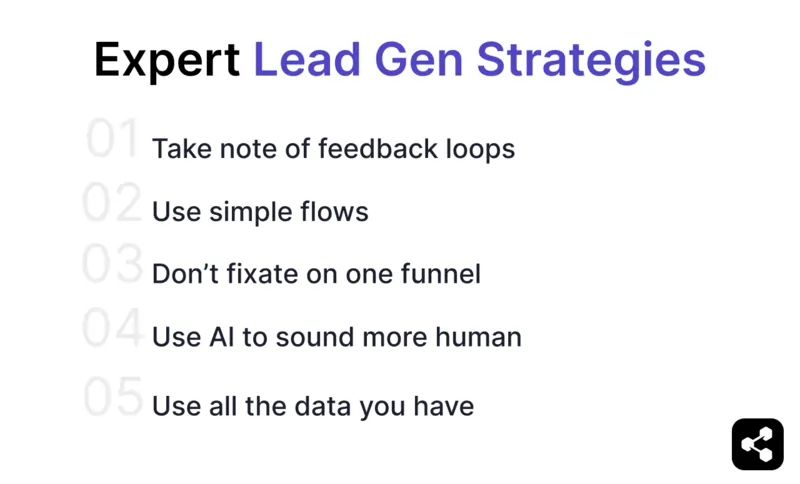
The director duo at Envyro has been helping companies implement AI lead generation for years. As you can imagine, they’ve picked up a thing or two along the way.
Here are their top tips for companies looking to start using AI lead generation.
1. Check in on your feedback loops
The best solutions are constantly improving. And the only way to improve is to monitor feedback and work it into your updates.
Vasileski and Arsik recommend looking at transcripts of conversations to identify where users tend to drop off. “Usually there’s a sticking point where people drop off. If you’re not looking, then you can’t improve it.”
Possible sticking points might be asking for too much information, asking for information your lead doesn’t think is relevant, not being upfront with the value exchange – like, why should they give you their data?
Another way to refine your system? Track how leads perform after qualification. Are they converting? Are sales reps flagging issues with the quality of leads? AI is great at optimizing patterns, but only if you’re feeding it the right insights.
2. Reduce friction with simple flows
“Sometimes people have an idea of a flow in their head, but on paper it ends up being way too long,” explains Vasileski. “Their users have to give a ton of information and they end up losing them.”
Their advice? Cut it all the way down.
Reduce your flows to only the essentials. A chatbot’s job isn’t to get every detail possible — it’s to get the right details without making the lead work too hard. Try implementing:
- Multiple choice answers instead of full typing responses
- Progressive profiling, where you collect data over time, instead of all at once
And test, test, test. If too many leads drop off, trim the fat and make it easier.
3. Don’t fixate on one funnel
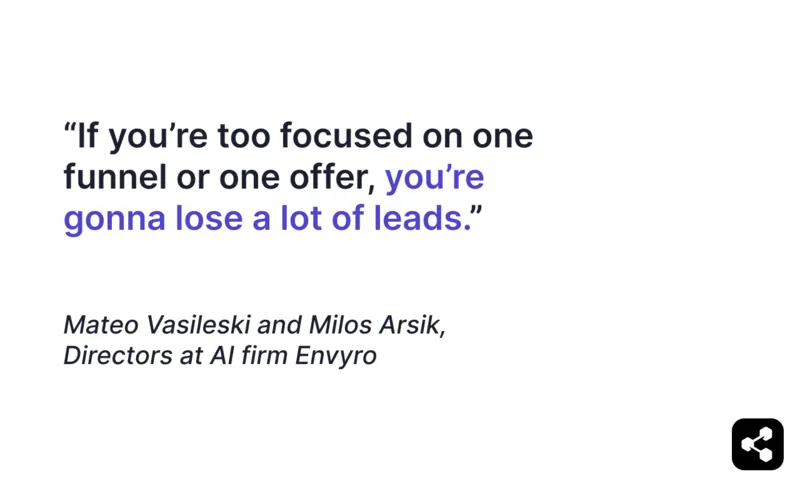
There might be one ideal pathway for your leads — let’s say you want to sell them your bread and butter, a standard $500/month software subscription. (We’ve been there.)
Even if this is your company’s main goal, you’ll lose leads if your flows are restricted to the ‘ideal’ outcome. (Again, we’ve been there).
“If you’re too focused on one funnel or one offer, you’re gonna lose a lot of leads,” explain the Envyro guys. “Your customers might want something different or cheaper, so you need to be dynamic.”
If a lead isn’t ready to commit, offer a free guide instead. If someone’s a big spender, get your bot to notify a human in real-time – they can jump in via human-in-the-loop if needed.
In short, offer different flows for different needs.
4. Use AI to sound more human
You don’t need to trick a user into thinking they’re speaking to a human
“Most conversational AI sounds robotic and boring,” says Arsik. “But AI is advanced enough these days that an AI agent can sound very human.”
I’ve previously covered how to make a chatbot sound more human. But here are the most important takeaways:
- Use natural phrases (like ‘Hey there!’ instead of ‘Hello. How may I assist you?’)
- Keep it short and concise
- Acknowledge user input (‘That makes sense. Here’s what I recommend.’)
- Add a little personality. A little warmth goes a long way.
5. Use all the data you have
Know your lead’s name? Bake it into your chatbot’s flows. Have any information about them — industry, company size, source? Use it to personalize their experience.
This is some classic chatbot marketing 101.
The more relevant your flow is, the more helpful it’s gonna be, the more engaged your leads are. The more willing they are to give up their email in exchange for something that’s gonna make their life easier.
How to Avoid Common AI Lead Gen Challenges
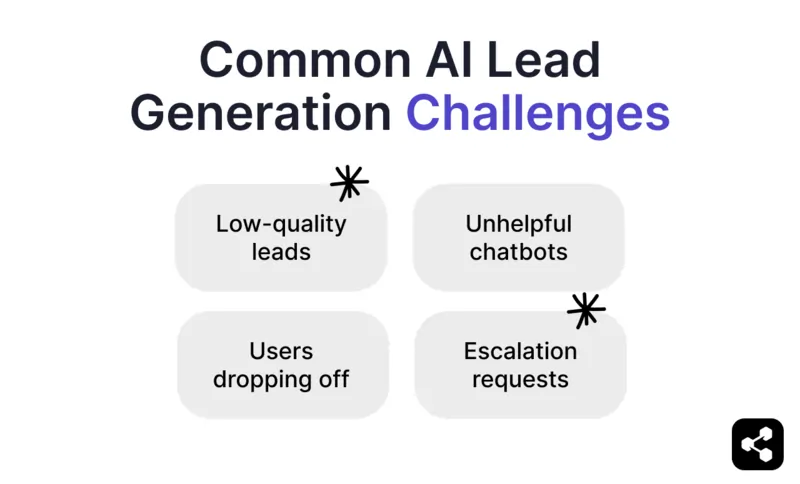
We’ve helped deploy thousands of lead generation chatbots (literally, thousands).
And how will we use our power for good? By sharing with you how to avoid some of the most common mistakes companies make when deploying chatbots.
You’ll run into some issues — but if you play it right, you can probably avoid these four common issues.
How to avoid users dropping off without leaving contact info
A common problem for new builders is that their users like the information the chatbot gives – but they don’t want to give any information in return.
As we know, conversational marketing is all about ease and value.
If your users are talking to the bot, but leaving before giving their contact information, try:
- Making your lead capture request more natural and tied to value (“Want a free strategy guide on growing your ad agency? Drop your email and I’ll send it over if you want.”)
- Gather information progressively, rather than all at once – ask for their industry and engage a bit before asking for the size of their company
- Provide auto-reply buttons, so that users can respond with the click of a button
How to avoid collecting low-quality leads
If your chatbot produces more leads, but they’re lower quality, it’s not solving the problem.
Try improving lead qualification questions to filter out more prospects, like asking their budget or when they’re looking to implement a solution.
Instead of “How can we help?” ask, “Are you actively looking for a solution or just exploring?” That way, you’re not chasing people who aren’t ready to buy.
If pricing comes up, don’t just drop a link—ask for their budget range first. If they’re vague, dig deeper: “Are you looking for something quick and easy, or a long-term solution?”
Your chatbot should feel like a helpful guide, not a lead form. Qualify first, capture info second.
How to avoid an unhelpful chatbot
Your users have questions, but your chatbot doesn’t know how to answer them. These kinds of dead-end conversations aren’t just useless, they create frustration.
You can improve your chatbot’s knowledge by:
- Expanding the Knowledge Bases that it draws from. If users keep asking for specific details about your product, service, or pricing, ensure your chatbot has access to the right information.
- Adding a fallback flow. Just because your bot can’t provide a specific answer doesn't mean it can’t provide any answer. Instruct it to do the best it can in providing helpful and relevant information
- Analyzing conversation logs. Review past chats to identify common questions the bot fails to answer, then train it to respond more effectively.
- Providing a seamless handoff. If a chatbot can’t help, make sure it connects users to a human rep quickly and smoothly — without making them repeat themselves.
How to avoid an onslaught of requests to speak to a human
Chatbots allow your users to self-service. But weak chatbots are just a middleman between the user and the eventual human assistance.
Identify what users want from an employee that the bot couldn’t provide. Changing their account details? Faster service? More information?
Do everything your team can do to bring these elements into your bot. Connect it to more Knowledge Bases, reduce the number of questions, or provide more personalized information upfront.
Deploy AI lead generation this month
I want you to improve your ROI next month, not next year.
You’re interested in AI lead gen, and we have the most flexible AI agent platform – and if you want, we even know a few guys who are pretty experienced in building AI systems.
Botpress offers a suite of pre-built integrations (including CRMs, analytics, and scheduling tools), a host of educational resources, and a partnership network — if you want to enlist someone else to build your AI lead gen system.
With affordable plans, no mark-up on AI spend, and unlimited use cases, our platform has been used to deploy AI agents and chatbots by over 500,000 builders.
Start building today. It’s free.
FAQs
Can you use AI to generate leads?
Yes, AI can be used for lead generation. AI-powered tools like chatbots, AI agents, and automation software help businesses identify, engage, and qualify leads.
Can ChatGPT do lead generation?
ChatGPT can engage prospects, answer questions, and collect lead information, but it lacks built-in sales automation. For a full lead generation strategy, businesses often use AI chatbots or AI agents designed for sales.
How do I automate lead generation?
You can automate lead generation by using AI chatbots, CRM integrations, and automated email campaigns. These tools help capture leads, follow up with prospects, and personalize outreach without manual effort.
What is AI for lead generation?
AI for lead generation refers to the use of intelligent automation to find, engage, and qualify potential customers. It includes AI chatbots, virtual assistants, and sales automation tools that streamline outreach, capture leads, and optimize the sales process.
What is the best AI lead generation tool?
While there are plenty of options on the market, an AI chatbot or AI agent is the most comprehensive AI technology for B2B lead generation. The best AI lead generation tool will be able to seamlessly integrate into your existing systems.
What are the best AI marketing strategies?
Infusing AI into your marketing strategies is best done through a comprehensive AI tool like a chatbot or AI agents. This software allows your company to automate repetitive tasks and enhance strategy through your business processes.
How can I use AI to get quality leads?
Lead generation tools like AI agents are able to identify and qualify leads. Since they can analyze customer data and prospect data, they’re able to find underlying patterns and accurately predict high quality leads.





.webp)

